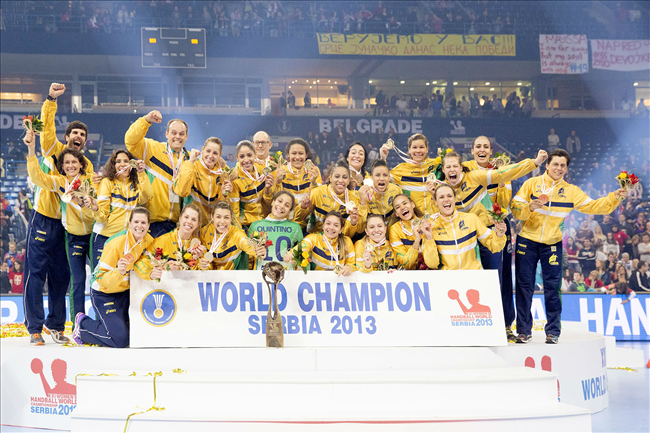After we have now had time to celebrate the Brazilian triumph, there may still be some additional observations to make. First of all, I was delighted to the see the highly unusual amount of coverage in Brazilian media, perhaps in part because the event coincided with the vacation period in football… There were proud comments along the lines: “The girls are as good with their hands as the boys with their feet!” And it has also been interesting to review the comments in European media. One can find a mixture of reactions: selfish worries that the World Championship is no longer an internal European affair, delight that we now have an indication that handball is really a global sport, and above all attempts to explain why the Brazilians came out on top.
On that last point, I think there is general recognition that this should not really have been such a surprise, because Brazil has shown consistent strength for a while now. But many point to the experience gained by most of the players in European top club competition, and the fact that as many as six of the best players are now playing and training together under coach Soubak at Hypo. There is also a recognition that the Brazilians have been able to develop a style that is modern and dynamic, with players who do not look so big and intimidating but nevertheless are athletic, quick and tough. Many also commented on their ability to handle the pressure of some 20,000 spectators mostly supporting their opponents.
There has also been some speculation that it is not a coincidence that some of the perennial top teams from Europe seemed to struggle a bit. So some commentators suggest that it is the unrealistic pressure of having five top events in four years that is having its effect. In every four-year period, the Europeans have to deal with a continental championship that in terms of quality and demands does not have its equivalent in the other continents. And it is tough to put together a team in top form so frequently, as there is no time to integrate new players and to cope with injuries or other reasons for some ‘ups and downs’. But on the other hand, the European teams generally have a much larger pool of top players than their non-European rivals, so that should make for more flexibility and resilience.
Many have noted that the Brazilian victory will enable PanAmerica to field five teams, including Brazil, in 2015. There are two ways of looking at this. One, is the excitement of being able to have additional teams get the opportunity to face the highest level of competition and that this will encourage efforts and improvement in several federations around the continent. But, if one looks at the very feeble performance of the weaker Panamerican representatives this year, it seems that it could turn out to be bad for both the event and for the Panamerican image in 2015, unless several teams really make major strides in their development of more competitive teams. And, that is not going to be easy so soon!
Of course, I cannot avoid commenting also on the refereeing. Personally, I was pleased to see the progress of some younger couples. But, many media reports and comments from participating teams suggest that they were not so impressed by the overall standard in Serbia. It was noted that, if one removes the couples which will soon be in Denmark for the Men’s EURO 2014 and who could not realistically be in both events, it seemed that it could have been possible to insert some other experienced couples instead of some of those who were not seen as having reached a high level. Especially, I noticed the usual remarks that the IHF (and the EHF) seem to discriminate against the women’s championships. One important aspect is then the endeavor to use some couples with female referees. Regrettably, my own observations suggest that there has not been much progress in the last 5-10 years in terms of quality and stability on the part of the better female couples. Perhaps we see more female couples in EHF competition, but do they get the necessary support (including in their home countries) to reach the level required in a World Championship?
Finally, the despotic IHF president again decided to ignore common sense and the advice from the real experts around him. In the ‘consolation round’ for positions 17-24 he suddenly and capriciously ordered the Referee Committee to split up the established couples and experiment with combinations of referees who have never been on the court together before. Perhaps he felt he could get away with this nonsense because all the teams involved were from outside Europe, and all the referees involved were either women or from other continents. As I have written extensively before, and as I argued with the IHF president during my own years in the IHF, the concept of ‘mixed couples’ (as opposed to ‘fixed couples’) should never be considered for the international events, until and unless all the top handball countries were to decide that this is generally the best approach and therefore introduce it for their national leagues, such as Bundesliga, ASOBAL, Haandbold Ligaen, Ligue Nationale de Handball etc.

